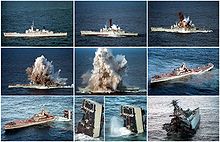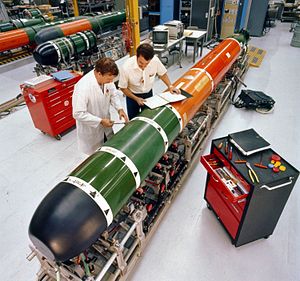- Mark 48 torpedo
-
For the machine gun, see Mk 48 machine gun.
Mark 48 torpedo Type Heavyweight torpedo Place of origin  United States
United StatesService history In service 1972–present (original), 1988–present (ADCAP)
2008-present Mod 7 Common Broadband Advanced Sonar System (CBASS)
Used by  United States Navy
United States Navy
 Royal Australian Navy
Royal Australian Navy
 Royal Canadian Navy
Royal Canadian NavyProduction history Manufacturer Gould/Honeywell (original), Hughes Aircraft (ADCAP) Unit cost $894,000 (US 1978)[1]
$3,500,000 (ADCAP) (1988)[2]
$3,800,000 (CBASS)[3]Specifications Weight 3,434 lb (1,558 kg) (original), 3,695 lb (1,676 kg) (ADCAP) Length 19 ft (5.79 m)[4] Diameter 21 in (533 mm)[4] Effective range 23 miles,[4] 38 km at 55 kn (102 km/h) or 50 km at 40 kn (74 km/h) (estimated),[5] officially "greater than 5 miles"[6] Warhead high explosive plus unused fuel Warhead weight 650 lb (295 kg)[4] Detonation
mechanismproximity fuze Engine swash-plate piston engine; pump jet Propellant Otto fuel II Maximum depth 500 fathoms,[4] 800 m (estimated),[5] officially "greater than 1200 ft"[7] Speed 55 kt[4] (estimated),[5] officially "greater than 28 kt"[6] Guidance
systemCommon Broadband Advanced Sonar System The Mark 48 and its improved ADCAP (Advanced Capability) variant are heavyweight submarine-launched torpedoes. They were designed to sink fast, deep-diving nuclear-powered submarines and high-performance surface ships.
Contents
History
The Mk-48 torpedo was designed in the end of the 1960s to keep up with the advances in Soviet submarine technology. Operational since 1972, it replaced the Mk-37 and Mk-14 torpedoes as the principal weapon of U.S. Navy submarines.[2] Discontinued use in the Canadian Navy of the Mark 37 was due in part to it's nasty habit of turning around and "acquiring" the platform which had just fired it. With the entry into service of the new Soviet Alfa class submarine in 1979, the decision was made to accelerate the ADCAP program, which would bring significant modifications to the torpedo. Tests were run to ensure that the weapon could keep on with the developments and the weapon was modified with improved acoustics and electronics. The new version of the weapon, also known as Mk-48 Mod 4, was extensively tested and production started in 1985, with entry into service in 1988. From then on, various upgrades have been added to the torpedo, of which the current version is the Mk-48 Mod 6, a mod 7 version was test fired in 2008 in the Rim of Pacific Naval exercises. The inventory of the U.S. Navy is 1,046 Mk-48 torpedoes.[5]
Deployment
 Former Royal Australian Navy ship, HMAS Torrens (DE 53), hulk target, engaged by RAN submarine HMAS Farncomb (SSG 74); 1999
Former Royal Australian Navy ship, HMAS Torrens (DE 53), hulk target, engaged by RAN submarine HMAS Farncomb (SSG 74); 1999
The Mk-48 torpedo is designed to be launched from submarine torpedo tubes. The weapon is carried by all U.S. Navy submarines, including Ohio-class ballistic missile submarines, Seawolf, Los Angeles and Virginia class attack submarines. It is also used on Canadian, Australian and Dutch submarines. The Royal Navy elected not to buy the Mark 48, preferring to use the Spearfish instead.
Mk-48 and Mk-48 ADCAP torpedoes can be guided from a submarine by wires attached to the torpedo. They can also use their own active or passive sensors to execute programmed target searches, acquisition and attack procedures. The torpedoes are designed to detonate under the keel of a surface ship, breaking the ship's back and destroying its structural integrity. In the event of a miss, it can circle back for another attempt.
Propulsion
The swashplate piston engine is fueled by Otto fuel II, a monopropellant that decomposes into hot gas when ignited, which drives the engine. The thrust is generated by a propulsor assembly.
Sensors and improvements
The torpedo's seeker has an active electronically steered "pinger" that helps avoid having to maneuver as it closes with the target. Unconfirmed reports indicate that the torpedo's sensors can monitor surrounding electrical and magnetic fields. This may refer to the electromagnetic coils on the warhead (at least from 1977 to 1981), used to sense the metallic mass of the ship's hull and detonate at the proper stand-off distance.
The torpedo has been the subject of continued improvement over its service lifetime. In the 1990s, a Mod 6 variant of the ADCAP provided much improved noise isolation from the engine, which makes this torpedo more difficult to detect by a potential target.
The Mk48 Mod 7 Common Broadband Advanced Sonar System (CBASS) torpedo is optimized for both the deep and littoral waters and has advanced counter-countermeasure capabilities. The MK48 ADCAP Mod 7 (CBASS) torpedo is the result of a Joint Development Program with the Royal Australian Navy and reached Initial Operational Capability in 2006.[7]
On July 25, 2008 a MK 48 Mod 7 CBASS torpedo fired by an Australian Collins-class submarine successfully sank a test target during the Rim of the Pacific 2008 (RIMPAC) exercises.[8][9]
Users
See also
- DM2A4 heavyweight torpedo
- Spearfish
- Tigerfish
- Yu-6 torpedo
References
- ^ Polmar, Norman. "The Ships and Aircraft of the U.S. Fleet: Torpedoes". United States Naval Institute Proceedings, November 1978, p.159.
- ^ a b "MK 48". Federation of American Scientists Military Analysis Network. www.fas.org. http://www.fas.org/man/dod-101/sys/ship/weaps/mk-48.htm. Retrieved 2011-04-06.
- ^ http://www.deagel.com/Torpedoes/Mark-48-CBASS_a001143002.aspx
- ^ a b c d e f Thomas, Vincent C. The Almanac of Seapower 1987 Navy League of the United States (1987) ISBN 0-9610724-8-2 p.190
- ^ a b c d "Mk 48 ADCAP". Jane's Naval Forces News. www.janes.com. http://replay.waybackmachine.org/20010401035621/http://www.janes.com/defence/naval_forces/news/juws/juws010202_1_n.shtml. Retrieved 2011-04-06.
- ^ a b "US Navy Fact File: Heavyweight Torpedo - Mark 48 ", US Navy, 17 January 2009, Retrieved 10 March 2010.
- ^ "Aussie sub sinks US Warship ", SMH, 25 July 2008
- ^ "BBC Video: Torpedo test sinks US ship". BBC. July 24, 2008. http://news.bbc.co.uk/2/hi/asia-pacific/7523147.stm. Retrieved 2011-04-06.
External links
U.S. Navy 'Mark'-series torpedoes Mark 10 torpedo • Mark 13 torpedo • Mark 14 torpedo • Mark 15 torpedo • Mark 18 torpedo • Mark 24 Mine • Mark 44 torpedo • Mark 45 torpedo • Mark 46 torpedo • Mark 48 torpedo • Mark 50 torpedo • Mark 54 MAKO Lightweight Torpedo • Mark 60 CAPTOR
Categories:- Cold War weapons of the United States
- Torpedoes of the United States
- Raytheon products
- Weapons of Canada
Wikimedia Foundation. 2010.

